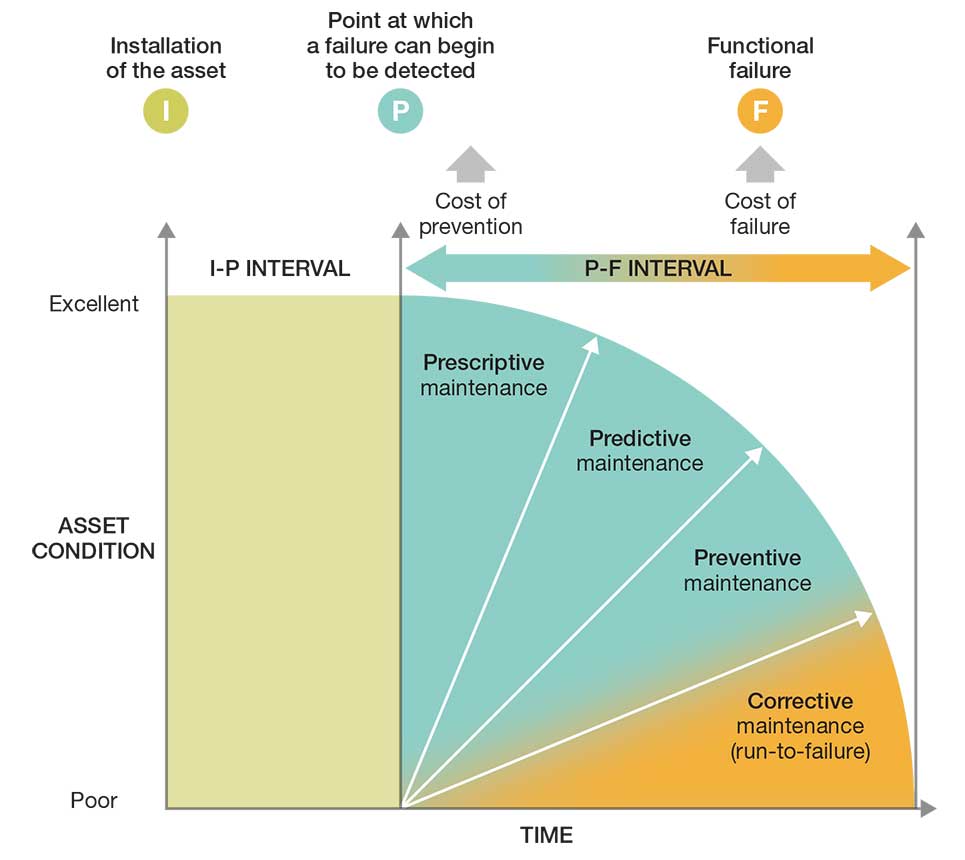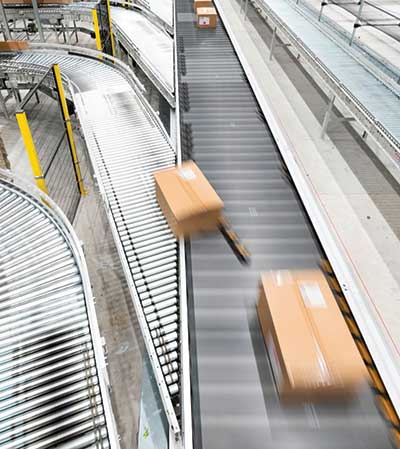Predictive maintenance: Ready to launch
You may not be on a path to predictive maintenance, but it’s worth a look. Predictive requires new habits, but has great promise. Don’t tell anyone, but there’s even a ChatGPT angle here.
In the beginning, predictive maintenance seemed so straight forward.
“Predictive maintenance is when you anticipate a failure based on real-time data and perform that repair or replacement before failure,” says Doug Schuchart, global materials handling and intralogistics manager at Beckhoff.
Gone are the days when maintenance happens only after failure. At the other end of the spectrum, predictive maintenance “gets away from replacing parts with plenty of life left in them because the preventive maintenance schedule says it’s time,” says Paul Reichenberger, director of technical parts and support at SDI.
But to use a trite phrase that rings all too true here—the devil is in the details. In fact, the real-life, real-time practice of predictive maintenance is all about details. Quite simply, new sensors, processes and even people need to be put in place to collect, manage, analyze and react to all that data. This isn’t trivial.
“Predictive maintenance has been a buzzword for some time,” says Derek Lang, Swisslog’s vice president of customer service. “Everyone wants to be able to monitor equipment condition and react to that condition, but, like cold fusion, the industry as a whole isn’t there yet.”
And just for the record, Lang fully expects predictive maintenance will be a standard practice long before the secrets of cold fusion are unlocked.
When asked how he rates interest in predictive maintenance, Lang uses a 1 to 10 scale, with 10 the highest.
For equipment suppliers, he puts interest at an 8/9. For end users like you, he pegs interest at 5/6.
Clearly, predictive maintenance is on people’s minds.
Dematic asset management
The benefits of preventive maintenance (the P-F curve)

Four maintenance buckets
To get started, let’s establish a framework to guide you from where you are to where you want to go. Brett Webster, director of product management at Dematic, offers the chart above.
As you can see, Webster breaks maintenance into four buckets: corrective (run to failure), preventive, predictive and prescriptive.
On the vertical axis, each bucket intersects an asset’s condition from poor to excellent. On the horizontal axis, Webster breaks time into data points ranging from installation of the asset to the point at which a potential failure is first detected and then all the way to actual, functional failure. Across that continuum, there is a corresponding cost of prevention and cost of failure.
Webster says more than 95% of companies are either in the corrective or preventive maintenance buckets. Predictive is the next stage. However, only the most advanced maintenance departments, operations and techs are even dabbling in predictive.
The fourth bucket—prescriptive—is really on the bleeding edge. No joke.
“This approach,” says Webster, “takes predictive maintenance a step further by not only predicting equipment failures, but also prescribing the necessary steps to prevent the failure. Using complex algorithms, machine learning and data analysis, prescriptive maintenance provides specific recommendations for maintenance activities.”
Did you catch that? Machine learning. As in artificial intelligence (AI). And just to be clear, AI is not in this story because ChatGPT is all over the news. Suppliers say ChatGPT will be a real thing in maintenance going forward. Details in a bit.
Onward and upward
Let’s return to: There’s got to be a way to collect, manage, analyze and react to all that data. “Please allow me to introduce myself,” says the devil.
It all starts with sensors. Sensors are required in motors, drives, sortation systems and all other types of materials handling equipment. They measure everything from temperature and vibration to wear and noise as well as power consumption and error messaging, to name six of more than 100 common data points in predictive maintenance. That’s according to Thomas van Workum, vice president of global lifecycle performance service at FORTNA.
Only trouble is, there are few, if any, sensors built into most of the installed base of materials handling equipment today. While some advocate retrofitting existing equipment, others focus only on new equipment.

Schuchart at Beckhoff is in the retrofit camp, with good reason. He says to move toward predictive maintenance now it is important to begin a practice of collecting data, “even if you don’t have a strategy for how to analyze it.” The idea being that data collection is the first step toward predictive maintenance. You have to make that a standard practice first.
Schuchart continues to say end users should, at this point, insist on sensors built into materials handling equipment and related components they are now buying. Fortunately, suppliers appear already pointed in this direction and many are already building sensor-populated equipment.
SDI’s Reichenberger points out that sensors and an Internet of Things (IoT) network to organize and move the collected data is the next step in the predictive maintenance process.
Or as Schuchart says, the idea is to connect the flow of data “from the sensor to the cloud.”
FORTNA’s van Workum talks about translating that data into performance analytics. “It’s the art of gathering data and translating it into valuable information. You want to know how each component in a system is performing and identify the deficiencies against preset KPIs,” adds van Workum.
He continues, “if you can find data patterns and use them to set performance analytics, then you can start to predict future performance and decide what really needs to be maintained and when.”
“This is at the heart of where predictive maintenance offers serious potential,” adds Schuchart, “Taking data from sensors on the machine to train a machine learning model begins the automation of the discovery of patterns and predicted outcomes. That trained model, an inference, can then be run in real time on the programmable logic controller (PLC) to locally analyze new data and alert a user to an impending failure.”
This is where AI enters the picture.
Where AI fits
Let’s be clear up front: AI and machine learning have been, for some time, expected players in making predictive maintenance tick. And that was well before ChatGPT burst on the scene last November.
That’s when the company OpenAI released its large language model-based chatbot called Chat Generative Pre-Trained Transformer. It has many potential uses from helping with your kid’s homework to writing music and scouring software for errors. Using information fed to it, ChatGPT develops iterative improvements on its previous output, learning as it goes, also known as regenerative AI.
ChatGPT is also considered to have some real potential in predictive maintenance. What exactly that might be, however, is not especially well defined quite yet.
Several suppliers are at the science experiment stage with ChatGPT and predictive maintenance. Webster of Dematic talks about having ChatGPT, which he calls a giant step forward, scour maintenance manuals as a starting point. The next step is to download sensor data from a materials handling system and let ChatGPT come to some conclusions about the need for maintenance on a particular part.
“We’re really just getting started here now,” says Webster. “We wouldn’t take it to an end user yet. But next year we may be able to consider launching a beta project or two with interested companies.”
“ChatGPT has already been integrated into Beckhoff’s TwinCAT automation platform,” says Schuchart, “and is being utilized in many ways as an AI tool including assisting in diagnostics as well as programming functions.”
“AI will identify new patterns and where deviations are in systems. AI will be the key component to convert data to an algorithm that will recommend or at least suggest a necessary maintenance action. In five years the systems and AI will tell us what’s going on, directly sending to techs the details about what needs attention now.” - van Workum
That said, Lang of Swisslog warns “AI is not the easy button. It will identify conditions that require attention, but the rest is left to the maintenance techs. A person will still have to do an on-the-spot assessment of what needs attention, and ultimately determine required actions.”
Along those same lines, SDI’s Reichenberger strongly emphasizes the critical role of techs in the future success of predictive maintenance.
In fact, all of the experts in this story made it crystal clear that AI in predictive maintenance will not displace people. Instead, this is a perfect situation for AI to be a functional tool that makes people more effective. Techs are not going away, but they will be better informed in a more timely manner when time matters.
Not waiting for AI
Now that we’ve scratched the surface of AI, it’s clear that no one is suffering from suspended animation in anticipation. Instead, suppliers are well along on dashboard schemes and software that makes predictive maintenance a manageable practice in even the busiest facilities. Here are some examples.
Webster talks about Dematic’s alert monitoring system. He says it combines software components with customer support, sending notifications in several formats to techs and others who need to know so they can take needed actions. “It’s the eyes of the system,” says Webster.
Condition monitoring is part of Swisslog’s SynQ service-based modular software platform, explains Lang. “The platform allows data from all sensors to be aggregated and analyzed in novel combinations that create new insights into system performance and maintenance needs,” he continues.
Beckhoff’s approach includes its TwinCAT Analytics tool for data analysis from many machines, says Schuchart. “The analysis includes a variety of algorithms for both live and historical data,” he adds.
The tool runs on industrial controllers that act like flight recorders networked by EtherCat (60 million nodes according to chips sold worldwide across all industries) that are instrumental in collecting large amounts of data on the edge in the programmable controller all the way to the cloud. It also supports extremely fast update rates for high-speed machine control.
As FORTNA’s van Workum observes, “predictive maintenance is a big-promise crystal ball. Most everyone believes in it already. And some are working on it now. But, today, no one has the answers.” Then again, we may well be on the cusp.













